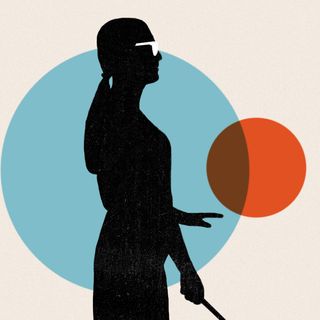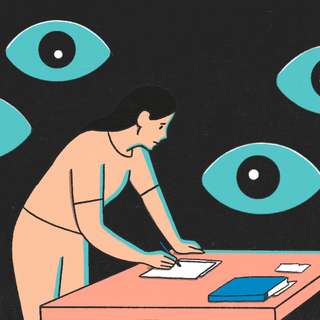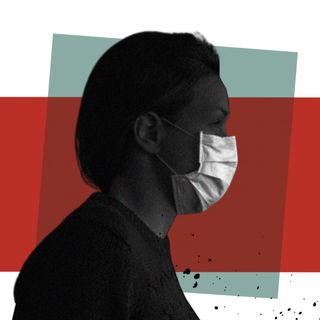
‘Masking’ for Years Can Leave Autistic People Confused About Who They Really Are
“When you’re acting all the time, you tend to get confused between the character you’re playing and yourself.”

“When you’re acting all the time, you tend to get confused between the character you’re playing, and yourself,” A.B., now 30, who had started masking when she was in college, explains. I can relate.
While I have been masking as far back as I can remember, I upped the game so much in my fourth year of law school that, overnight, I “appeared” to have turned into an entirely different person, according to people who knew me at the time. I’m autistic, and unbeknownst to myself, I was “masking” to hide my “neurodivergence” — words I’d never heard of at the time.
Masking is the suppression of one’s true self by neurodivergent people. It is known by many names — camouflaging, compensating, adaptive morphing. But the motivation behind it is the same: putting on one’s “best normal” to “fit in” so that they can avoid being pitied, patronized, babied, ostracized, hated on, harassed, or bullied for being different.
“It’s a survival strategy,” says Nidhi Singhal from Action For Autism (AFA), an NGO in New Delhi. “Consciously or unconsciously, one may model the tone of their voice, the words they use, their smile, their eye contact, even their general mannerisms… by observing other popular or ‘liked’ kids.”
However, people don’t often realize they’re masking because, over time, they begin to believe their masked selves are who they truly are. “Masking to me is like me being on autopilot to survive uncomfortable situations… I only realized that I was doing it [when I became aware of my autism],” Shayonee, 32, says.
Camouflaging can limit one’s understanding of their strengths, traits, comforts, and discomforts, and as Singhal points out, even hamper their “ability to trust their instincts.”
Related on The Swaddle:
Why We Expect People With Invisible Disabilities To Learn To Act ‘Normal’
“The first question that came up in my head when I realized I was neurodivergent was: ‘Who am I really?’” says Tanuka Ray, a psychotherapist from Kolkata. Not being able to tell which of her traits are masked and which belong to her, complicates her relationship with her neurodivergence.
This distortion of their self-identity — besides the impact of masking on their mental health — often devolves into an identity crisis for many autistic people. “In the long term, my whole perception of myself is twisted,” says A.B.
Shayonee, too, echoes A.B.’s concerns. “Even in my 30s, I don’t know much about who I really am,” she says. “I can’t bear to look back at pictures from a certain period — when my masking was at its peak — because I don’t know if that was really who I was.”
While not being able to look at pictures from the past might seem strange to many, I deeply empathize with Shayonee. When I look back at photos from my pre-diagnosis days, I feel I’m looking at a stranger wearing mybodysuit. How did I hug so many people when physical contact with people — especially hugging — is almost painful to me? How did I manage to interact with groups of more than five people when the sound of even two people talking at the same time quickly devolves into a sensory nightmare for me? The more I look at these digitally preserved moments from my past, the more confused I get.
“[N]ot knowing who they are, what their place is in the world… can be very confusing and impact one’s relationships, one’s friendships, even one’s career,” Gopika Kapoor had told The Swaddle in March this year. Kapoor is an autism consultant who has worked with Ummeed Child Development Centre, a Mumbai-based non-profit that helps children with developmental disabilities.
Shayonee, for instance, had her relationships with people impacted. “I find it very difficult to connect with people who knew me when I was masking. I feel that they will not understand this new person behind the mask because I won’t conform to what they expect to be my ‘normal’ [masked] self,” she says.
Unfortunately, despite making a consciousdecision to accept their neurodivergence, many individuals continue struggling to stop masking. A.B. calls this unconscious or subconscious tendency a “default setting” that often switches on automatically in social settings, especially when she finds her autistic self being rejected by people around her.
Lessons we learned in our formative years stay with us into adulthood. Unfortunately, for many autistic people, the lesson learned is to not be themselves. Tanuka says that even if she doesn’t feel the presence of any social deterrents eliciting the need to mask anymore, years of conditioning about how one is “supposed” to be, often takes charge.
Related on The Swaddle:
I Self-Diagnosed My Autism Because Nobody Else Would
To avoid masking, I’ve actively begun avoiding social interactions. Every time I interact with people, I mask. It’s almost uncontrollable — often, it’s because I don’t know how to be without my mask.
What I know is when I’m not masking, I can stim without a worry in the world, I don’t have to be anxious about my facial expressions, I’m not worried about failing to make eye contact or overdoing it, I can process stimuli at my own pace without being scared I’d be called “slow,” I can simply cuddle with my soft toys every time I’m overwhelmed since there’s no one around to judge me, and I can exist in positions I’m comfortable in — due to my proprioceptive differences (which impacts my awareness of the position and movements my body in any environment), most “regular” or “accepted” bodily positions make me uncomfortable. When I’m around people, I cannot do any of these things I find comforting. I feel like I’m constantly playing a character who isn’t me. The longer that goes on, the hollower I feel.
Tanuka believes transitioning into a “space of curiosity” about herself has helped her begin the process of overcoming the identity crisis brought on by years of camouflaging.
This curiosity-based approach has worked for me too. Instead of going by what my Instagram pictures “appear” to suggest, I try to recall what I was feeling when they were clicked. Often, the memories I have of the instances captured on camera are that of pain, discomfort, and anxiety. Most of all though, I remember an intense struggle to “fit in.”
This journey of discovering who I am underneath the mask isn’t an easy one. It involves long walks down memory lane and questioning almost everything I know about myself. However, the process can also be a rewarding one.
But while learning about who we are can mitigate the long-term impact of camouflaging, it doesn’t nip the necessity to camouflage at the bud. For that to happen, society needs to learn too — and quickly.
Singhal says, “More and more adults on the spectrum are now coming forward to share their life experiences. The non-autistic world has much to learn from that… We have to move away from a deficit and impairment-based perspective and learn to appreciate individuality rather than homogeneity.”
Devrupa Rakshit is an Associate Editor at The Swaddle. She is a lawyer by education, a poet by accident, a painter by shaukh, and autistic by birth. You can find her on Instagram @devruparakshit.
Related


What It’s Like To Live With: Cerebral Palsy
